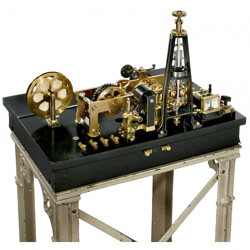The Hughes Printing Telegraph
he first printing telegraph was the House Printing Telegraph invented by Royal E. House in 1846. Instead of using a telegraph key, letters and numbers were entered by typing on a keyboard, which looked like a small version of a piano. At the receiving end, the corresponding letters and numbers would be printed on a paper tape. Thus, there was no need to learn any special codes like Morse or the codes used with the British Needle Telegraph.
The House Printing Telegraph was complex and difficult to manufacture. It ran off pneumatic power supplied by turning a crank on the machine. This required a second person (called the "Grinder") to turn the crank while the actual operator ran the telegraph
By 1852, the House Printing Telegraph was being used on 4 of the main telegraph lines in the U.S.
--------------
In 1855, David Edward Hughes, a music teacher living in Kentucky, invented his own version of the printing telegraph. Like the House Printing Telegraph, Hughes invention used a keyboard to enter the letters and numbers directly, without the need to learn any codes. Letters typed at the transmitting end would be printed on paper tape at the receiving end. Unlike the House instrument, the Hughes Printing Telegraph was powered by a large weight on a rope (like the weight-driven telegraph registers) so there was no need for a "Grinder" to turn a crank.
Another feature of the Hughes instrument was the use of a spinning cylinder with 26 pins protruding from the cylinder in a helical pattern. The cylinder rotated at a constant 120 RPM. When a particular key was pressed, it would make contact with the corresponding pin for that letter, generating a voltage pulse. By knowing the time difference between the start of the rotation and when a specific key was pressed, that would determine which letter key was pressed.
The Hughes Printing Telegraph was used for a short time in the U.S. by the American Telegraph Company but it was used extensively in Europe, well into the 20th Century !
Many pictures exist showing rooms with Hughes Printing Telegraph sets in training schools in Eastern Europe; yet strangely, very few Hughes Telegraph sets exist today. What happened to all of them ??
More info about Hughes and details about the technical operation of his printing telegraph can be found on the David Edward Hughes website.
(Click on the pictures below to see larger versions of the photo)
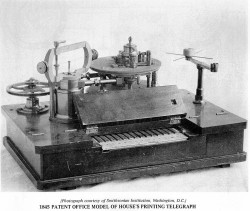 |
The Patent Model for the House Printing Telegraph, 1845 (Smithsonian Museum) |
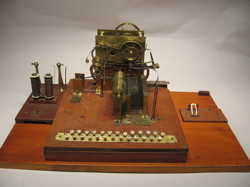 |
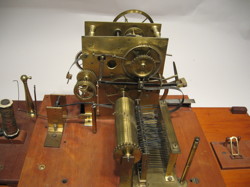 |
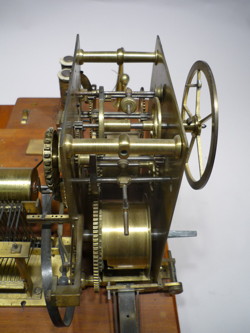 |
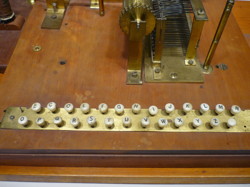 |
Pictures of the 1855 Patent Model for the Hughes Printing Telegraph. The 2nd picture shows the rotating cylinder with contact pegs. (Smithsonian Museum)
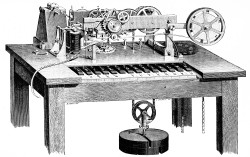 |
A line drawing of the Hughes Printing Telegraph, from an unknown European textbook |
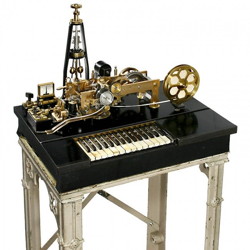 |
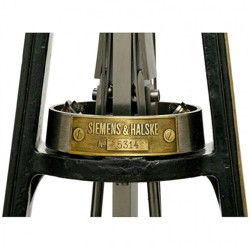 |
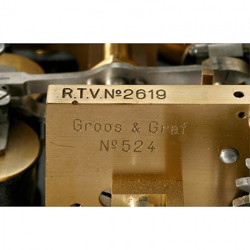 |
An early 1900's example of a Hughes Printing Telegraph on metal stand by Siemens & Halske / Groos & Graf
 |
 |
 |
 |
Another Hughes Printing Telegraph Set by R. Stock & Co. Berlin
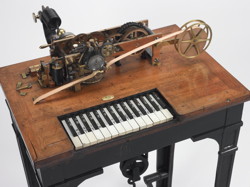 |
A late 1800's example of a Hughes Printing Telegraph used by the British Post Office |
|---|
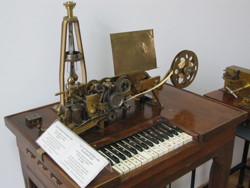 |
Another early 1900's example of a Hughes Printing telegraph, made by Siemens & Halske in St. Petersburg, Russia. Note the keyboard has both English and Cyrillic characters |

